Our Home Supercluster, Laniakea, Is Dissolving Before Our Eyes
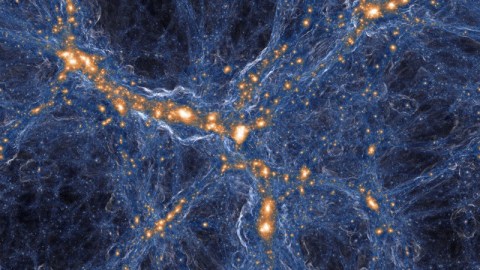
If galaxies are cities in the Universe, how unfortunate that our ‘cosmic country’ is dissolving.
On the largest cosmic scales of all, planet Earth appears to be anything but special. Like hundreds of billions of other planets in our galaxy, we orbit our parent star; like hundreds of billions of solar systems, we revolve around the galaxy; like the majority of galaxies in the Universe, we’re bound together in either a group or cluster of galaxies. And, like most galactic groups and clusters, we’re a small part of a larger structure containing over 100,000 galaxies: a supercluster. Ours is named Laniakea: the Hawaiian word for “immense heaven.”
Superclusters have been found and charted throughout our observable Universe, where they’re more than ten times as rich as the largest known clusters of galaxies. Unfortunately, owing to the presence of dark energy in the Universe, these superclusters — including our own — are only apparent structures. In reality, they’re mere phantasms, in the process of dissolving before our very eyes.
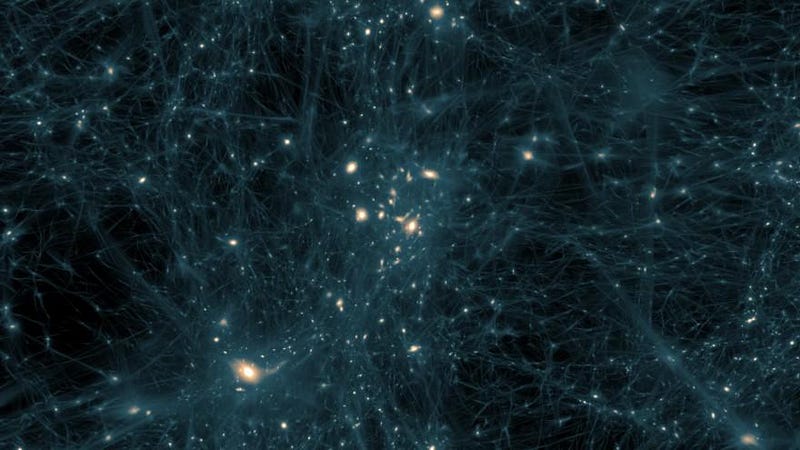
The Universe as we know it began some 13.8 billion years ago with the Big Bang. It was filled with matter, antimatter, radiation, etc.; all the particles and fields that we know of today, and possibly even more. From the earliest instants of the hot Big Bang, however, it wasn’t simply a uniform sea of these energetic quanta. Instead, there were tiny imperfections — at about the 0.003% level — on all scales, where some regions had slightly more or slightly less matter-and-energy than average.
In each one of these regions, a great cosmic race ensued. The race was between two competing phenomena:
- the expanding Universe, on one hand, which works to drive all the matter and energy apart,
- and gravitation, which works to pull all forms of energy together, causing massive material to clump and cluster together.
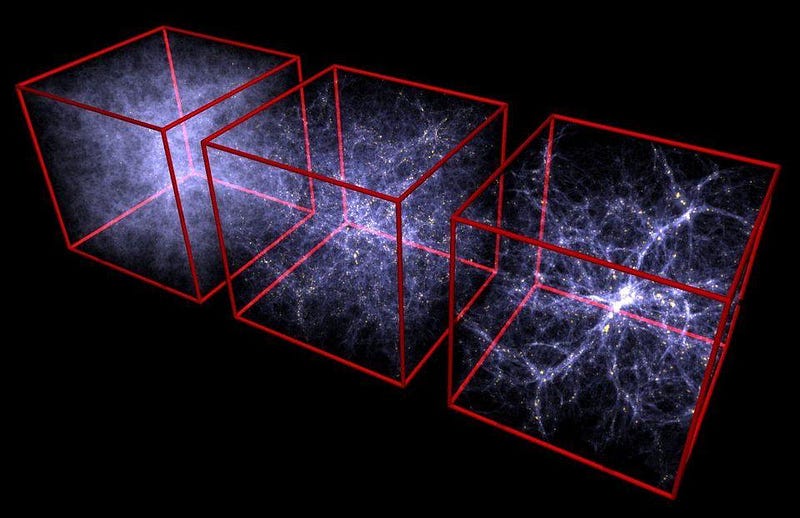
With both normal matter and dark matter populating our Universe — but not in sufficient quantities to cause the entire Universe to recollapse — our Universe first forms stars and star clusters, with the first ones appearing when less than 200 million years have passed since the Big Bang. Over the next few hundred million years, structure begins to appear on larger scales, with the first galaxies forming, star clusters merging together, and even galaxies growing to attract matter from the lower-density regions nearby.
As time continues to pass, and we cross from hundreds of millions of years to billions of years in our measurement of time since the Big Bang, galaxies gravitate together to form the Universe’s first galaxy clusters. With up to thousands of Milky Way-sized galaxies in them, massive mergers form giant elliptical behemoths at the cores of these clusters. At the modern extremes, galaxies like IC 1101 can grow to quadrillions of solar masses.
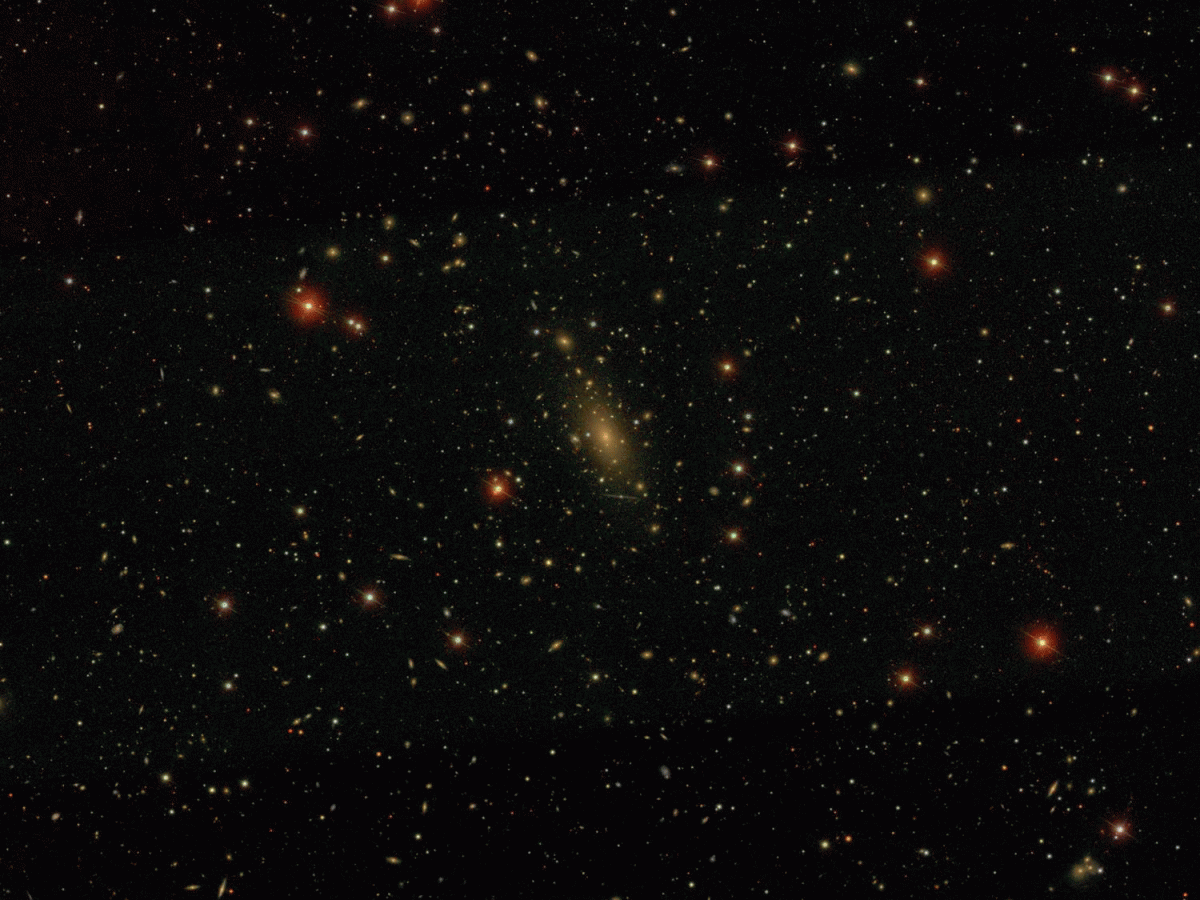
On even larger spatial scales and even longer timescales, the cosmic web begins to take shape, with filaments of dark matter tracing out a series of interconnecting lines. The dark matter drives the gravitational growth of the Universe, while the normal matter interacts through forces other than gravity as well, leading to the formation of gas clumps, new stars, and even new galaxies on long enough timescales.
Meanwhile, the space between the filaments — the underdense regions of the Universe — give up their matter to the surrounding structures, becoming great cosmic voids. Galaxies dot the filaments, and fall into the larger cosmic structures where multiple filaments intersect. On long enough timescales, the most spectacular nexuses of matter even begin attracting one another, causing galaxy groups and clusters to begin forming even larger structures: galactic superclusters.
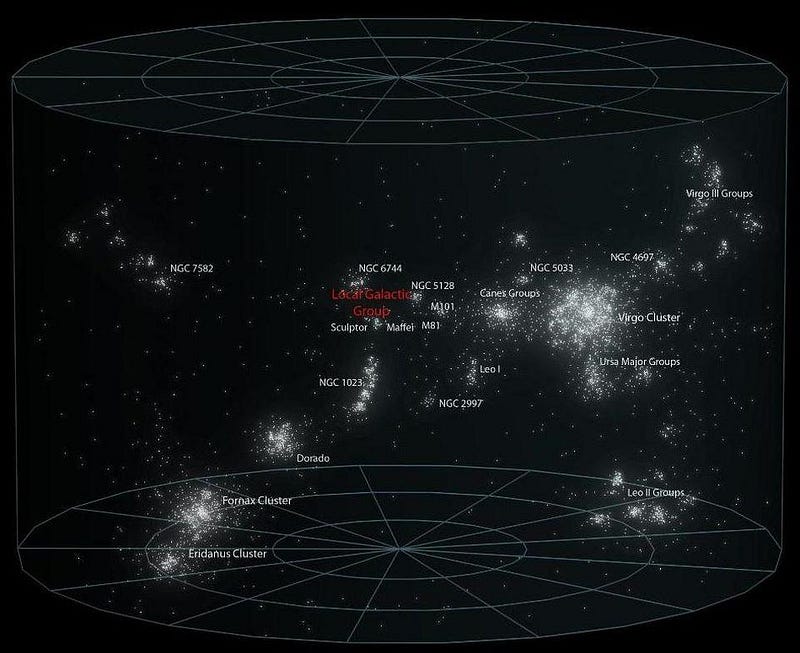
Superclusters are collections of:
- individual, isolated galaxies,
- galactic groups,
- and large galaxy clusters,
all connected by great cosmic filaments that trace out the cosmic web. Their gravitation mutually attract these components towards a common center-of-mass, where these large structures span hundreds of millions of light-years and contain upwards of 100,000 galaxies apiece.
If all that we had in the Universe were dark matter, normal matter, black holes, neutrinos and radiation — where the combined gravitational effects of these components fought against the Universe’s expansion — superclusters would eventually reign supreme. Given enough time, these enormous structures would mutually attract to the point where they all merged together, creating one enormous, bound cosmic structure of unparalleled proportions.
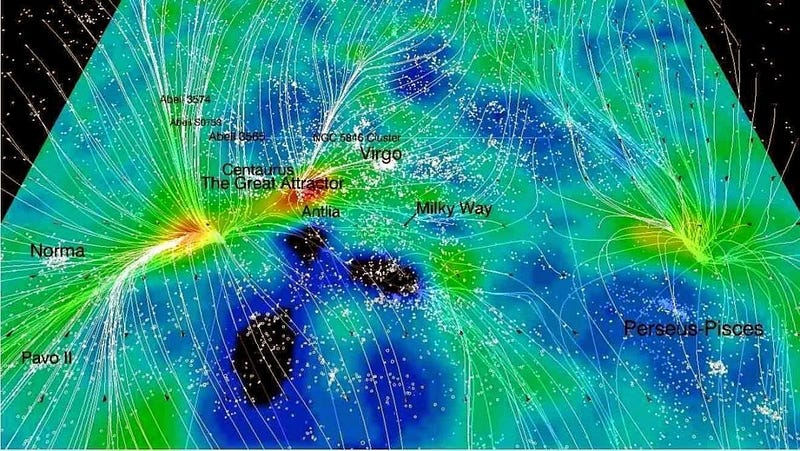
In our own local corner of the Universe, the Milky Way can be found in a small neighborhood we call our local group. Andromeda is our local group’s largest galaxy, followed by the Milky Way at #2, the Triangulum galaxy at #3, and perhaps 60 significantly smaller dwarf galaxies strewn out over a volume spanning a few million light-years in three dimensions. Our local group is one of many small-ish groups in our vicinity, along with the M81 group, the Sculptor group, and the Maffei group.
Larger groups — like the Leo I group or the Canes II group — are also abundant in our nearby surroundings, containing around a dozen large galaxies apiece. But the most dominant nearby structure is the Virgo Cluster of galaxies, containing more than a thousand galaxies comparable in size/mass to the Milky Way, and located just 50–60 million light-years away. The Virgo cluster is the main source of mass in our nearby Universe.
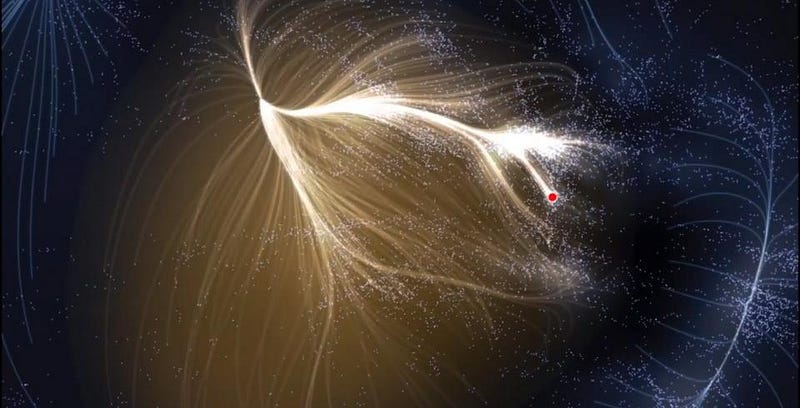
But the Virgo cluster itself is just one of a large number of galaxy clusters, themselves collections of hundreds to thousands of large galaxies, that have been mapped out in the nearby Universe. The Centaurus cluster, the Perseus-Pisces cluster, the Norma cluster and the Antlia cluster represent some of the densest and largest concentrations of mass close to the Milky Way.
They conform very well to this idea of the cosmic web, where “strings” of galaxies and groups exist along the filaments connecting these large clusters, and with giant voids in space separating these mass-containing regions from one another. These voids are tremendously underdense, while the nexuses of these filaments are excessively overdense; it’s very clear that on cosmic timescales, the underdense regions have given up the majority of their matter to the denser, galaxy-rich clusters.
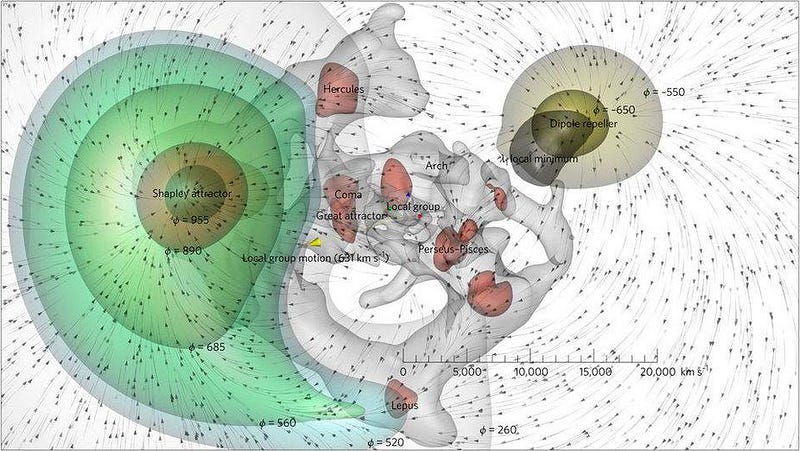
In our larger galactic neighborhood, going out for around one or two hundred million light-years, all of these clusters (excepting Perseus-Pisces, which lies on the other side of a nearby void) appear to have filaments with galaxies and galactic groups between them. It appears to make up a much larger structure, and if you sum up every galaxy in it — large and small ones alike — we fully anticipate that the total number should exceed 100,000.
This is the collection of matter that we refer to as Laniakea: our local supercluster. It links up our own massive cluster, the Virgo cluster, with the Centaurus cluster, the Great Attractor, the Norma Cluster and many others. It’s a beautiful idea that represents structures on scales larger than a visual inspection would reveal. But there’s a problem with the idea of Laniakea in particular and with superclusters in general: these are not real, bound structures, but only apparent structures that are currently in the process of dissolving away entirely.
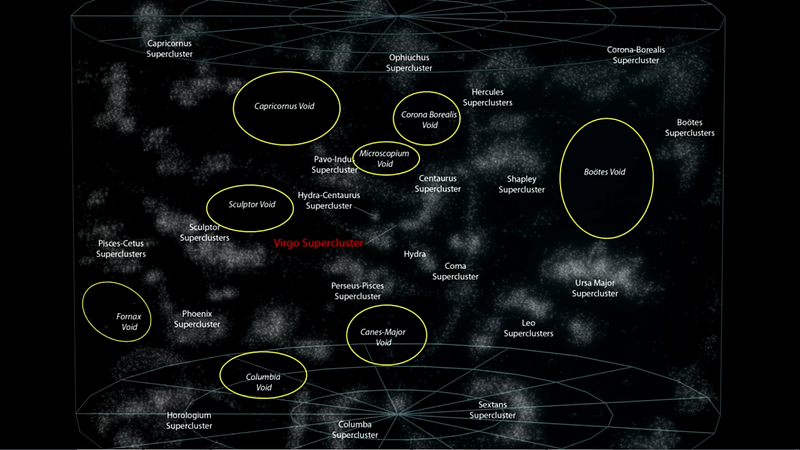
Our Universe isn’t just a race between an initial expansion and the counteracting gravitational force caused by matter and radiation. In addition, there’s also a positive form of energy that’s inherent to space itself: dark energy. It causes the recession of distant galaxies to speed up as time goes on. And — perhaps most importantly — it gets more important on larger scales and at later times, which is particularly relevant for the existence of superclusters.
If there were no dark energy, Laniakea would most certainly be real. Over time, its galaxies and clusters would all mutually mutually attract, leading to an enormous grouping of 100,000+ galaxies, the likes of which our Universe has never seen. Unfortunately, dark energy became the dominant factor in our Universe’s evolution approximately 6 billion years ago, and the various components of the Laniakea supercluster are already accelerating away from one another. Every component of Laniakea, including every independent group and cluster mentioned in this article, is not gravitationally bound to any other.
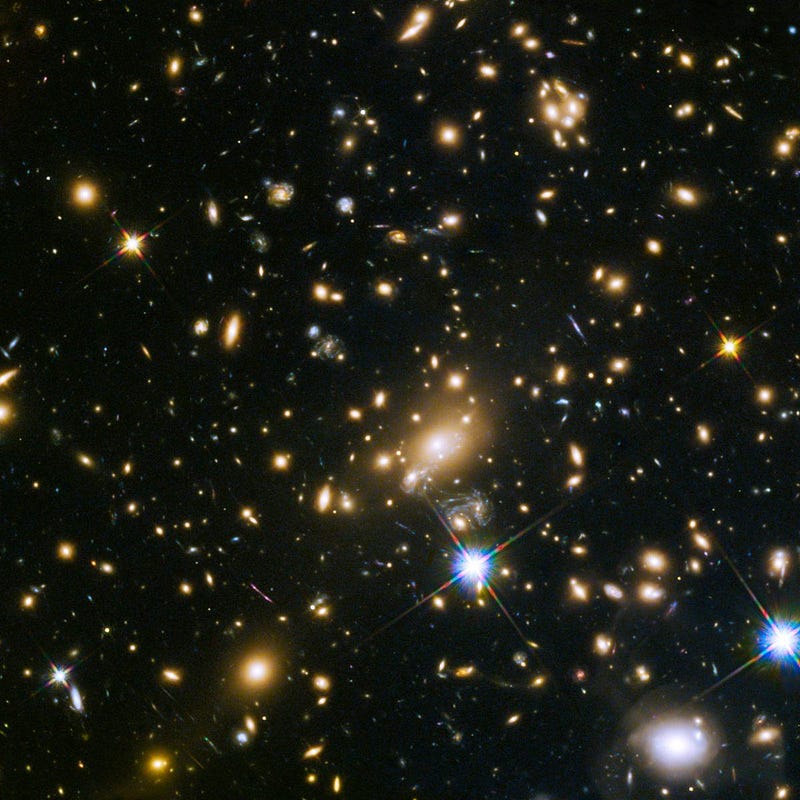
Every supercluster that we’ve ever identified are not only gravitationally unbound from one another, but they themselves are not gravitationally bound structures. The individual groups and clusters within a supercluster are unbound, meaning that as time goes on, each structure presently identified as a supercluster will eventually dissociate. For our own corner of the Universe, the Local Group will never merge with the Virgo cluster, the Leo I group, or any structure larger than our own.
On the largest cosmic scales, enormous collections of galaxies spanning vast volumes of space appear to be real — the Universe’s superclusters — but these apparent structures are ephemeral and transient. They are not bound together, and they will never become so. In fact, if a structure had not already accumulated enough mass 6 billion years ago to become bound, when dark energy first dominated the Universe’s expansion, it never will. Billions of years from now, the individual supercluster components will be torn apart by the Universe’s expansion, forever adrift as lonesome islands in the great cosmic ocean.
Ethan Siegel is the author of Beyond the Galaxy and Treknology. You can pre-order his third book, currently in development: the Encyclopaedia Cosmologica.





